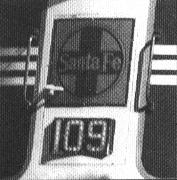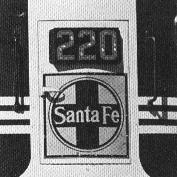Santa Fe FT Modeler's Notes |
|
|
MODELERS' NOTE BOOK by the Santa Fe Modelers Staff All FT's were delivered from EMD printed as shown on the styling diagrams. As mentioned on the diagram and in the text, the yellow paint used was a lighter, creamier yellow than the chrome yellow paint used on the Santa Fe's E-units of the same time period. In fact, the chrome yellow remained relatively constant until the late 1960's. The creamy yellow paint was manufactured by Dupont and bore the trade name Duco. Duco was a nitrocellulose lacquer developed in 1924 and was one of the first paints formulated for spray guns. Efforts to obtain a paint chip of this creamy yellow paint (Duco 246-32564) were unsuccessful because Dupont"s archives do not contain any paint samples earlier than 1955! SFMO member Andy Sperandeo, editor of Model Railroader magazine, experimented with available model paints and compared them to color slides made in the 1940's and early 50's. He determined that using either Floquil or Scalecoat Erie-Lackawanna Yellow and 10% to 20 % Reefer White will yield as correct a color for the creamy yellow as we can realistically expect. Given the lighting conditions under which a model is viewed and all other "unknowns," further attempts to exactly match a prototype paint chip are probably fruitless (not to mention the personal preference of the modeler). The biggest problem in using the "new" color to available decals. Paint chips prepared using the paint formula above will be sent to Champ, Micorscale and Accu-Paint with the suggestion they re-formulate their products to match the prototype color. We have received enthusiastic response from all three decal makers and expect this change (and a few others) to be in effect within a reasonable time. In the interim, aggressive modelers should consider spray-masking the "catwiskers." The creamy yellow paint was replaced in March 1952 on 200-class units delivered from EMD, Duco number 254-373 (possible the same color as 254-31423). -the chrome yellow became standard. We might assume that any FT's repainted by the Santa Fe at that time were repainted with that color. However, research indicates the "cigar band" paint scheme was not introduced on new models from EMD until October 1953, Therefore it is generally accepted that all FT's that carried the "catwisker" paint scheme used the creamy yellow paint. After 1953 all repaints of FT locomotives followed the Santa Fe standard "cigar band" scheme as shown on the F-7 freight styling diagram. The red separating stripe was probably abbreviated on the first repaint by the railroad around 1947 as Santa Fe painting documents show it still "as delivered" as late as August 1945. It was eliminated altogether around 1951. These dates are based on the EMD styling diagrams, Santa Fe documents in our collection and photographic evidence. They may well be speculation but should serve as a general guide until (if ever) additional facts surface. The all blue experimental paint scheme was suggested by Santa Fe painting documents in January 1951 for both FT's and 200 class units. Units 102, 120, 133, 142, 155, 158, 170,195, 199, and 405 are known to have carried the paint scheme. -Jay Miller Nose Emblems One of the biggest surprises in researching the painting and lettering was our discovery of the details for the Santa Fe nose medallion (badge) that appeared on the FT's-and the 200 class F-7's. EMD graciously provided us with drawings of the badge plate and what we found was as follows: |
|
 |
As built, FT's 100-119 carried a badge plate made of solid bronze with the Santa Fe emblem painted in the dark blue paint. Apparently this was not too successful as the paint tended to get "sandblasted" away and a new badge was designed. In early 1943, the medallion background material was changed to steel and then painted dark blue. The cross and the outline were over-painted using bronze colored paint, leaving the "Santa Fe" and most of the background dark blue (see the color photograph on the inside front cover). The entire medallion was then baked in an oven yielding a medallion that looked the same but lasted much longer (and was probably cheaper since solid bronze was hard to get during the war years). |
 |
Differences in the early medallion appear in photographs but are caused by light reflecting off the early bronze. It has been suggested the early FT's were retrofitted with the new baked enamel medallion. One wonders what happened to them when they were replaced... Champ's decal emblem is as correct as one could expect given this new information. However, detailed drawings and specifications are being made available to all manufacturers. -Jay Miller |
|
Dynamic Brakes Three different external appearance for dynamic brakes were used on FT locomotives. The first 100, 101, 102 and 103 received one type which had no "boxes" on the ends and straight sided grids. First units 104 through 117 received another style with curved sided grids and no "boxes" The remainder of first 118 through the last unit produced featured "boxes." On each end of the straight-sided grids (be sure to check a roster for proper numbering based on renumbering and delivery dates). Also check out the photos of 111L and 111C as they reflect the second and third types. Hallmark's brass imports feature the last version making them correct for the units listed above. -John Moore, Lee Berglund, and Jay Miller |
|







